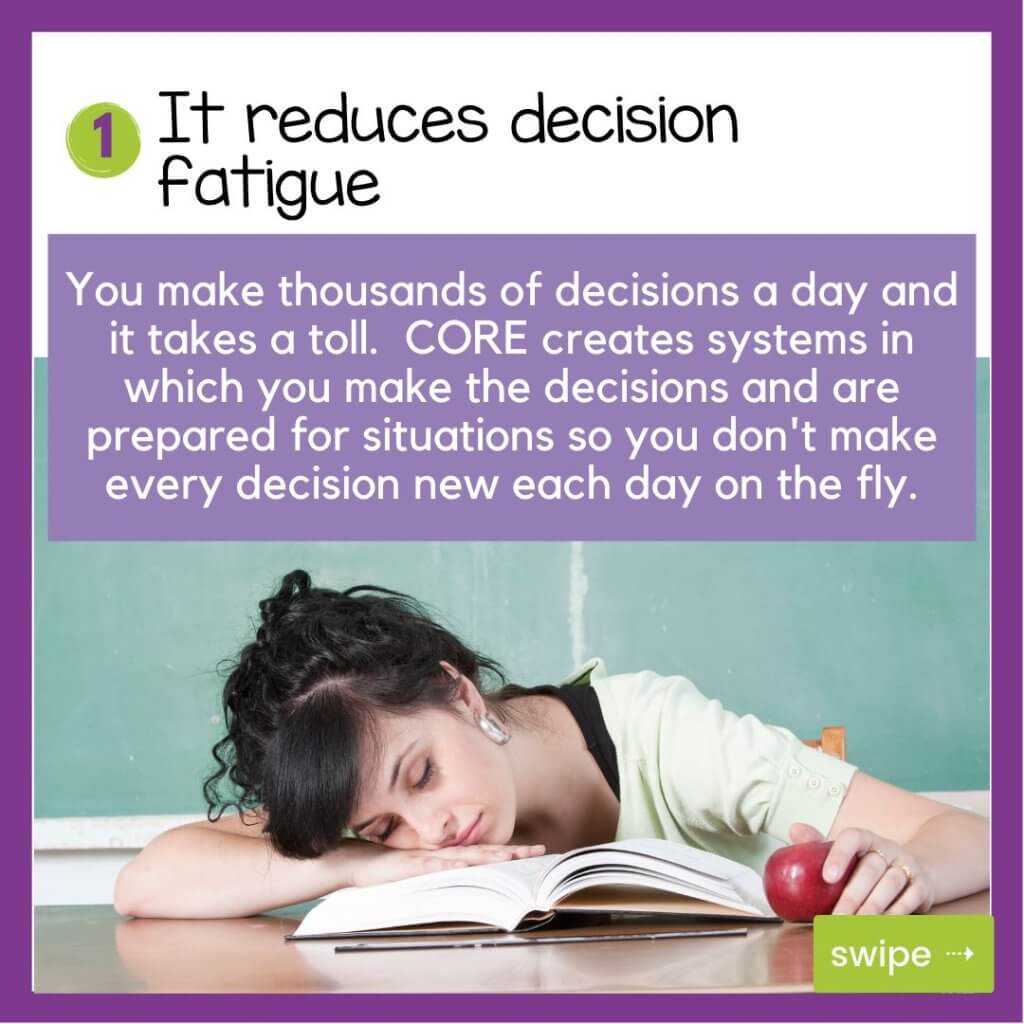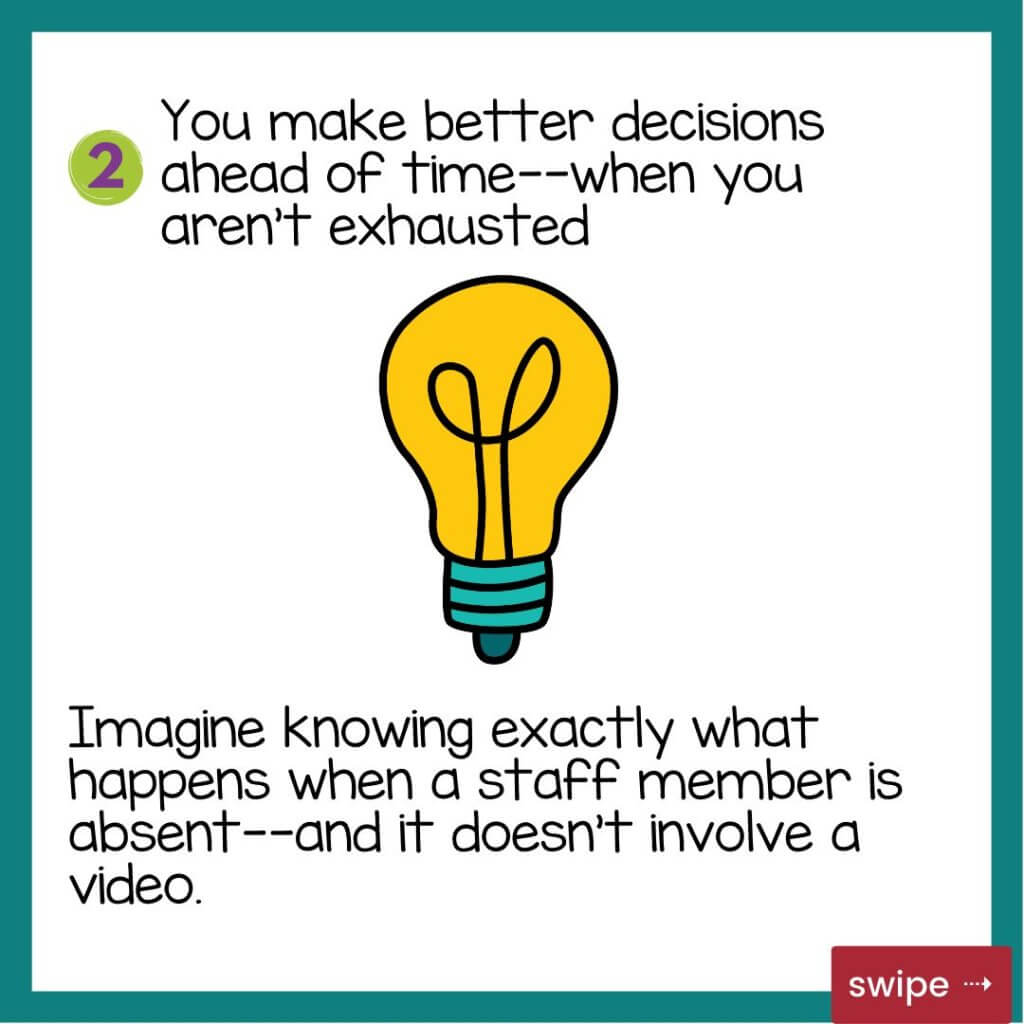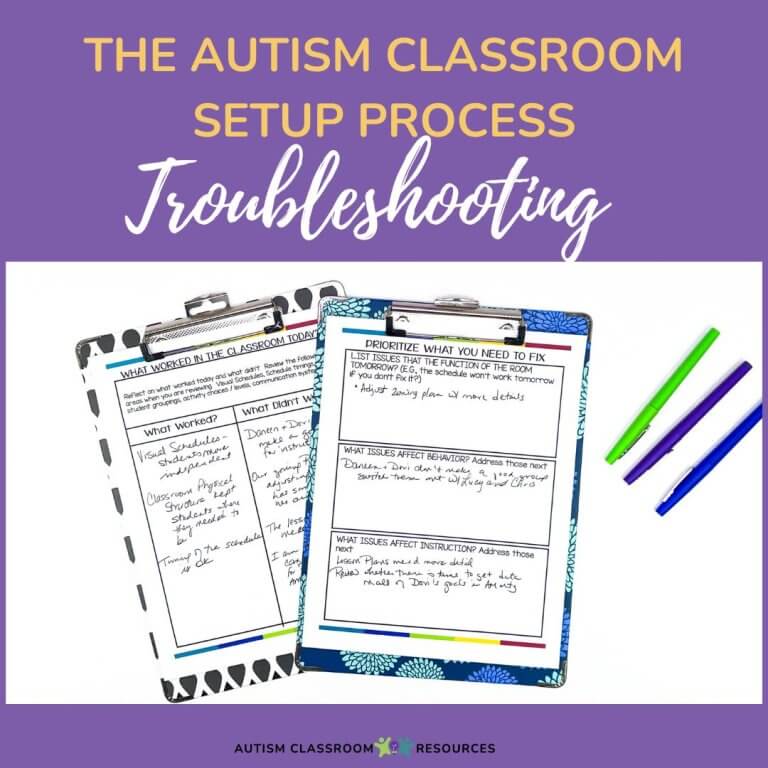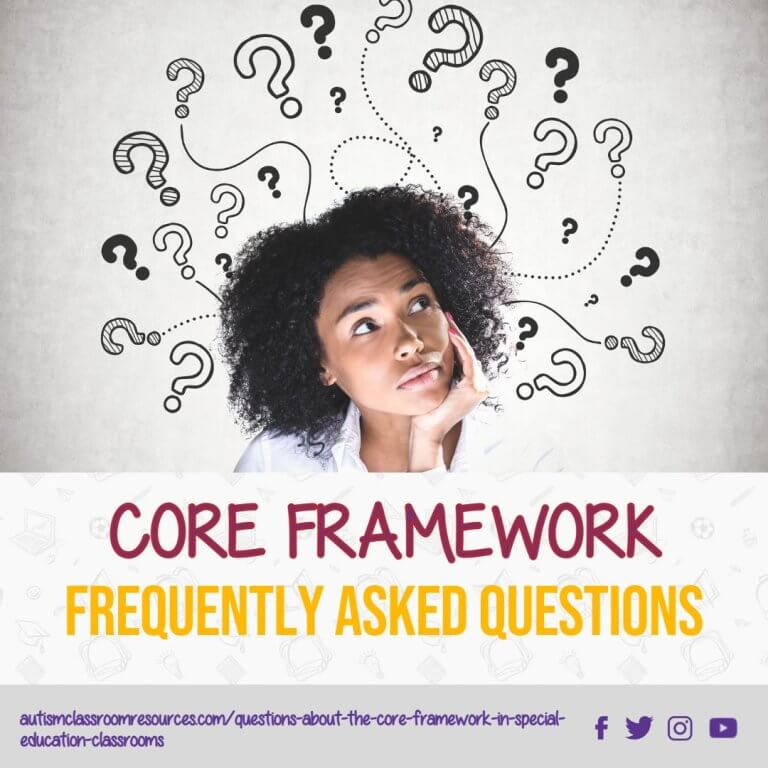I don’t know about you, but the last few years have brought on a real need for all of us to attend to how to reduce teacher stress, particularly in special education. I’ve been talking about the CORE Framework in the past few episodes of the podcast and on the blog. But I’ve focused primarily on why it’s good for our students. But, the CORE Framework offers a lot of benefits for teachers and staff as well. So this post is going to focus on how the CORE can help you feel better about your teaching job and stop feeling like you are just fighting fires.
1. Reduce Decision Fatigue And Reduce Teacher Stress
One of the primary ways that the CORE framework reduces stress is by creating systems in which problems, or potential problems are prevented. If not prevented, then solutions for the problems (e.g., a behavior crisis) are planned out ahead of time.
Our brains like plans. When we have a plan, we don’t have to spend brain power and energy on anticipating what we will do in specific situations.
The CORE Framework does require some work up front, because it is about creating potential plans. So it includes setting up the schedule and the running of the classroom so the everyday routine fades into the background. And you no longer have to keep things like what happens next, or who is going to speech or where is Jalen in your head.
That clears out mental space in your brain to focus on the instruction of the students in front of you. There will be always be a million things running through a special educator’s mind. But the fewer million there are reduces teacher stress.

- What will I do if there is a delay in getting into the music room? (You have a list of activities to fill the time and keep students engaged)
- How will we keep the other students engaged if one student has a meltdown? (You have set up procedures for you and for the staff to keep the other students engaged if that happens.)
Making these and other decisions proactively saves you brain power so you can focus your thoughts on what you are teaching, what the students are doing, and the task at hand.
Decision fatigue is real and it’s one of the reasons that classroom staff are exhausted at the end of the day. It takes time to set up the systems at the start, but spending that time pays off when you can limit decisions to ones you never would have anticipated.
2. You Make Better Decisions When You Aren’t Overwhelmed or in a Crisis: And That Can Reduce Teacher Stress
In addition to avoiding decision fatigue, the decisions that you make when you are planning ahead and calm are better quality. No one makes great decisions when they don’t have time to think about potential outcomes, when they are being faced with aggression, or even just faced with a class of kids who are getting off task because the music teacher is running behind.

The advantage of taking the time to think through and develop plans for what to do when your students are off-task, or what to do when a staff member is absent are huge.
Imagine how much easier that 6 a.m. phone call is to take saying one of your staff will be absent when you just have to walk into the room, pick up the sub folder and you have a 1-person down schedule and zoning plan already ready to go.
3. The CORE Framework Focuses on Maintaining Student Engagement (and that means fewer crises)
Keeping students engaged is soooo much easier than getting them back on task once you’ve lost their attention. Engagement is so critical to learning that the CEC identified engaging instruction as a highly leveraged practice.
Engagement is like any type of momentum. If you can keep it going, it keeps rolling. But once it stops, it takes a lot more energy and time to get it going again.
The CORE Framework systems are all aimed at keeping students engaged throughout the day with limited “down time” waiting for things to happen. Most of our students are not that good at waiting (yet), and it’s a skill we do need to teach. But when it happens and it isn’t a great time to be a teaching moment, it seems like it’s contagious. And when everyone gets off task, it’s 10 times as hard to get everyone back on track. And that can be really stressful for staff.
So again, you are doing the work ahead of time of setting up routines for potential waiting times. You are making sure that your staff is aware of those procedures because you have written them down and modeled them. And then staff can implement them consistently across the board. These are all ways that the CORE Framework helps to avoid the loss of momentum when engagement is lost. And that can help reduce teacher stress.

4. Reduce Teacher Stress with Systems In Place For Staff Absences and Your Own
I talked earlier about having systems in place for staff absences as a way to reduce decision fatigue. It also reduces teacher stress on the morning you get that phone call. And it helps with keeping students engaged, because you already have a plan in place and don’t lose their attention when you get to a part of the day that requires all the staff. You’ve already adjusted.
Similarly, one of the beautiful elements of a good strong CORE foundation is that once you have earlier strategies in place, it takes less time to make more plans from them. For instance, once you have your schedule and zoning plan established, it’s not that hard to create a 1-person down (or even 2-person down) plan. It won’t be your ideal day, because I doubt many of you have extra staff just hanging out. But it will be a day (or more) that can keep the students engaged and you don’t have to think constantly about what will happen when you learn you’ll be short staffed.
Oh, and the CORE systems also help when you have a sub, because the plan has already been made with the schedule and zoning plan (e.g., you put the para in the teachers’ spot and the sub in the para’s duties). You can learn more about creating 1-person down plans here.
5. You Work More Efficiently, Which Means More YOU Time

Finally, one of the main advantages of putting the time in up front to create the CORE systems are that you work more efficiently. So you create systems for yourself that help you get things done more quickly. And that gives you more time to do what you want and results in reduced teacher stress.
Once you have a lesson plan template that is working, not everything on it is going to change each week. So it’s easier to write your lesson plans each week and have them ready to go so that staff can implement them while you teach other students.
Similarly, having a system of data collection and particularly of data analysis means that every week you summarize your data. Then you make decisions, and you move on.
The more you do it, the faster you get with all the systems, I promise. They take time up front to set up, but once you start them and work out the kinks, they allow you to work less and spend more time doing the things you want to do.
If you are interested in getting some of your time and energy back, and getting back to a classroom you love because you can focus on teaching, instead of managing, then you might want to join us in the Special Educator Academy.
We have a whole pathway setup for the CORE Framework with videos and how-to forms and tools to help you plan out your classroom. And when you hit a snag, you have a community of special educators who know just how you feel and can help you brainstorm solutions.
Click her to get get a 7-day free trial for the Academy to see if it’s a good fit for you.







